Survey provides an update on workplace issues for advanced practitioners
Every 2 years, the National Kidney Foundation surveys nurse practitioners, physician assistants and clinical nurse specialists to evaluate roles, compensation, benefits, satisfaction, call time and other issues. The link to the online survey is shared with all nephrology advance practitioners, despite whether they are NKF members.
The 15-minute Survey Monkey-formatted questionnaire was sent to members of the NKF Council of Advanced Practitioners (NKF/CAP). They were encouraged to share the link with any nephrology advanced practitioners (AP) they knew. The NKF sent out the link monthly, with a second monthly reminder from a member of the executive council mentioning the survey to the listserv. The American Academy of Nephrology Physician Assistants sent out the link three times to its listserv. The link was open from January 2018 to April 2018. Efforts to promote the survey were also made at the NKF Spring Clinical Meetings held in Austin, Texas.

Trends in nephrology
Of the 446 NKF/CAP members and other non-council APs who received the survey, there were 293 respondents (64%). While this was our lowest response rate compared to previous surveys, it was also the highest number of participants who completed the survey. Trends from the profile information showed that:
- APs are trending younger and more diverse than previous years. Of the respondents, 29% are 30 years or older; 25% are 40 years or older; and 24% are 50 years or older.
- Most respondents were women. This is an unchanged trend during the past 4 years.
- Ethnic minorities are increasing in the AP ranks; 7% of the surveys were completed by African Americans, 7% were Asian and 3% were Hispanic.
- Most respondents (83%), as in previous surveys, indicated they hold a master’s of science degree.

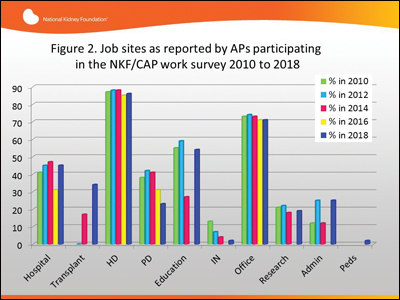
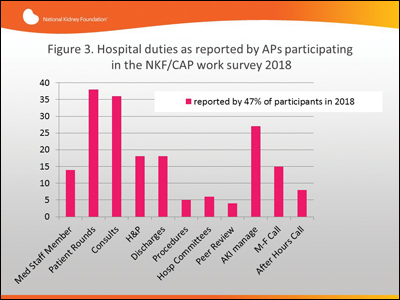
Not surprising, as the numbers of younger people entering nephrology increases, the numbers of seasoned nephrology APs are declining. Figure 1 shows the years of AP experience, with less than 5 years trending highest in 2018.
Work environment
Nephrology APs cover multiple sites including hemodialysis units, clinic/office, hospital, educational sites and research (Figure 2). There has been a sharp increase in the number of APs who manage transplant patients, rising from 17% in 2014 to 34% in 2018. Management of pediatric nephrology patients was added to the survey this year, and 2% of APs were noted to be in pediatric nephrology.
Of the 47% of APs who reported hospital duties, most (nearly 37%) rounded on patients. More than 35% managed nephrology consults (Figure 3). Consults were defined by participants as a request from a practitioner from outside the practice.
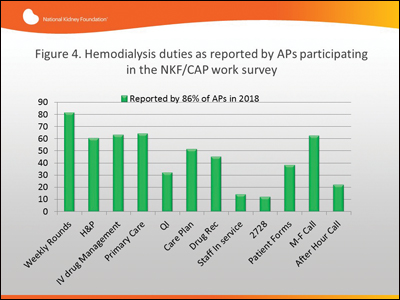
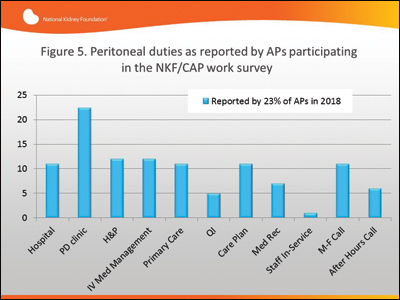
Consults done by APs have increased in prevalence by nearly 10% in the past 8 years. APs also were responsible for history and physical examinations (H&Ps), discharges and participation on hospital committees. Taking hospital call for the practice, both during regular working hours and after hours, was also a significant job duty for survey respondents.
Most APs (86%) reported managing patients on hemodialysis (HD; Figure 4). Weekly rounding, reported by more than 80% of APs, H&Ps, managing primary care issues, participating in care plans, participating in protocols for IV drug management and drug reconciliation duties round out the most common duties for the AP in the HD unit. More than 60% of APs took call for the dialysis unit during regular working hours, with a little more than 20% taking after hours call for the practices.
APs who responded to the survey managed patients, on average, in two to three HD units/week and spent 1 hour to 2 hours/week on the road; however, 20% reported 4 hours/week driving. Most APs manage 50 to 100 patients on HD/week although a little more than 25% of APs reported they see fewer than than 50 patients/week.
Home patients, participation in research
Twenty-three percent of APs in this year’s survey reported that they manage patients on PD, but that number has decreased in surveys during the last 4 years (41% in 2014 vs. 31% in 2016; Figure 2). For those who still see patients on PD, nearly 25% do the monthly rounds; 11% are involved in care plans and a similar percentage manage the patient on PD in the hospital (Figure 5). This downward trend of APs managing patients on PD also shows in the decrease in APs taking PD work day call; from 15% in 2014 to 11% in 2018.
Participation in research has also declined compared to previous years with 19% of APs reporting in this year’s survey that they had research duties. Most were responsible for home collection and monitoring of research patients. Attendance at investigator meetings has decreased by half among survey respondents since 2010. One could speculate that because our AP providers are newer to nephrology they may not have the experience to participate in research.
Professional education, office hours
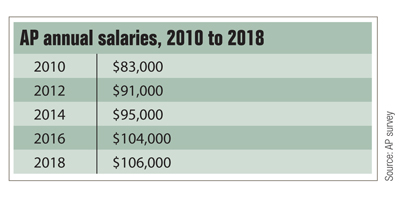
More than 50% of nephrology APs are involved in some type of teaching (Figure 6), including patients (22%), nurses (6.5%), training or mentoring the new AP (greater than 50%) and speaking at local and national meetings (23%). There was a decline in Kidney Disease Education (KDE) education duties from 2014 to 2018 (40% in 2014 vs. 22% in 2018).
After HD duties, the next most frequent site for APs was the office/clinic, with more than 70% of AP survey respondents providing care to patients in the office setting (Figure 7). Most office duties (65%) include the management of patients with CKD but a significant number of APs see acute patients; 48% of APs reported seeing hospital follow-ups, while 30% report acute work-in patients and 24% were seeing new patients. KDE classes were taught by one-third of APs, and primary care issues were managed by 14% of APs. Close to 25% of all APs took call for the office, but most did so during regular working hours.

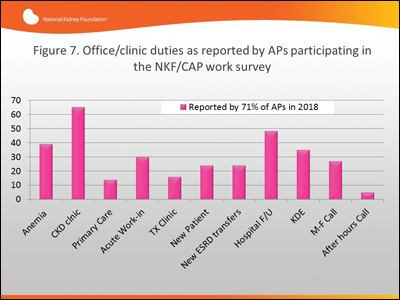
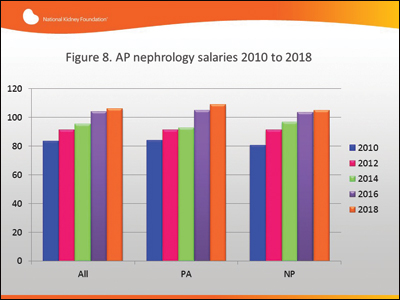
Salaries and benefits
Salaries for APs have continued to increase during the past 8 years, with most recent trends showing six figures for both NPs and PAs (Figure 8). This is a 20% increase in the past 8 years. However, the trend seems to have been flattening in the last 4 years. Salaries for PAs are slightly higher than NP salaries, but this may be due to either a gender or experience component.
The most common benefits continue to be continuing medical education, health insurance, malpractice and retirement accounts. This is similar to previous surveys. Most APs have 4 to 5 weeks off per year, but the 6-week per year group has decreased from previous surveys. This may be due to the trend of younger APs. Besides work life balance, time off, benefits and a competitive salary, APs value both the working relationship with their physician partners and the opportunity to give high quality care to their patients.
The NKF CAP Survey was designed to create an overall understanding of nephrology AP practice across the nation. APs continue to hold their own in the nephrology specialty area by managing chronic dialysis patients, transplant and acute care patients. They continue to mentor, educate and support new APs into the specialty, allowing improved access to nephrology specialty care in all areas.
- For more information:
- Christine Corbett, DNP, FNP-BC, CNN-NP, FNKF, is the corporate director of Advanced Practice Providers and a nephrology nurse practitioner at Truman Medical Centers, Kansas City, Missouri. Disclosure: Corbett reports no relevant financial disclosures.
